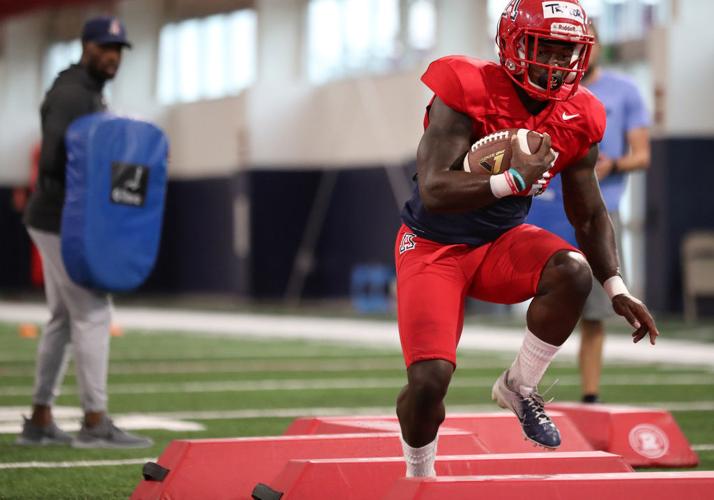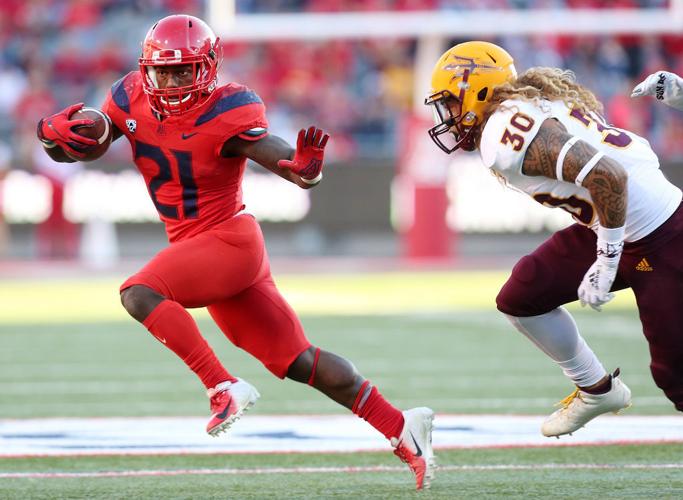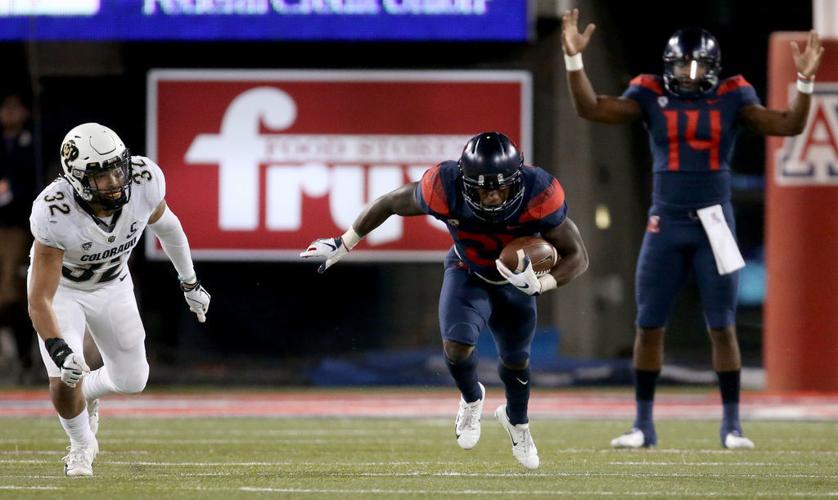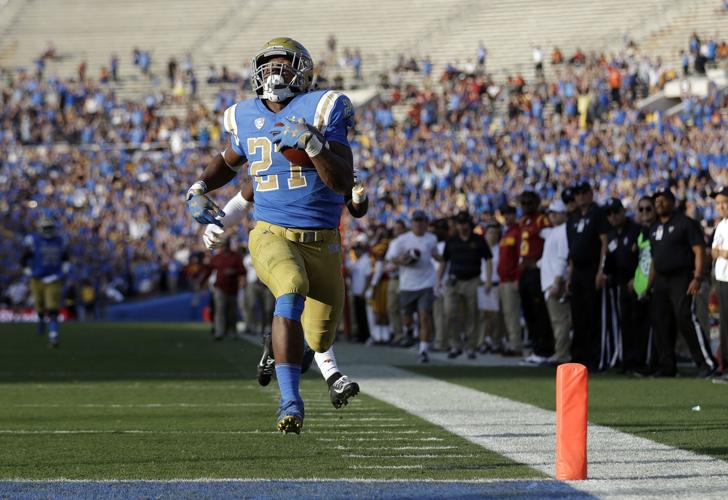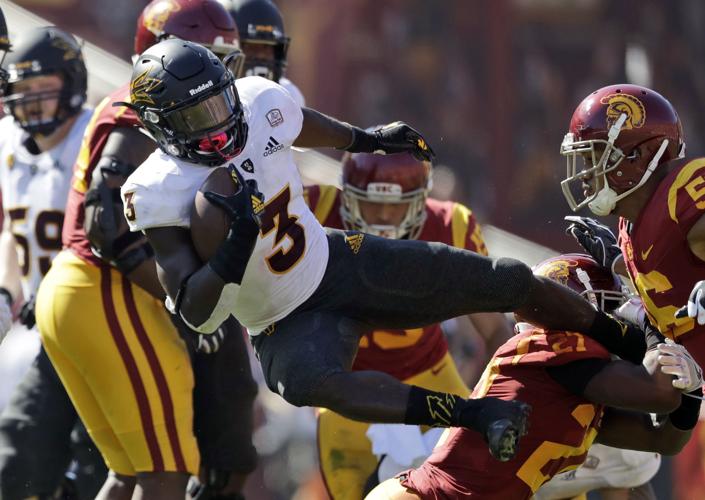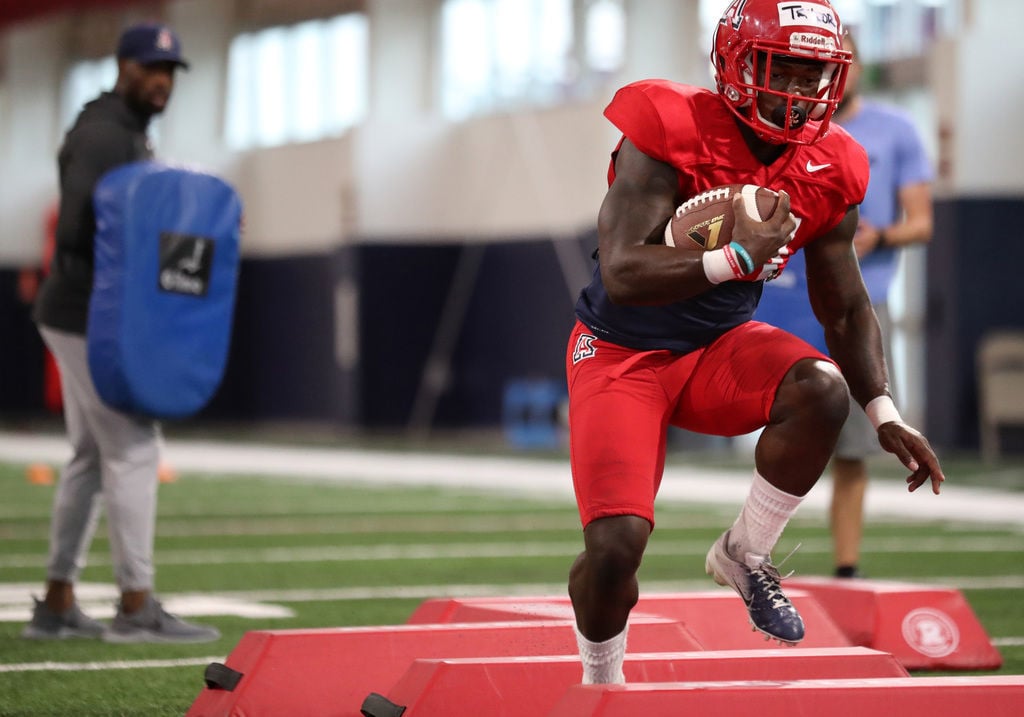If you’re a fan of pro football, you’ve probably heard some version of this thesis: Running backs don’t matter anymore.
They are fungible. Interchangeable. Not worth a high draft pick or a long-term investment.
In college football? To quote Lee Corso, the longtime conscience of the sport who thankfully is back in our lives: “Not so fast, my friend.”
Running backs — and the running game — remain a critical, fundamental element of the college game. It’s especially true in the Pac-12, whose brightest stars belie its reputation as a “finesse league.” And it’s irrefutable in the state of Arizona, where tailbacks are the foundations upon which offenses are built.
Only one conference had three of the nation’s 10 leading rushers last season. It wasn’t the SEC. It wasn’t the Big Ten. It was the Pac-12.
Those three players — Arizona State’s Eno Benjamin, Arizona’s J.J. Taylor and Oregon State’s Jermar Jefferson — were among five running backs representing their teams at Pac-12 Media Day last month. Only three quarterbacks were in attendance.
Nationwide, despite QBs dominating the Heisman Trophy race, college football remains a run-first sport. Even after shifting sacks — which technically count as rushing attempts — to the pass-attempt column, teams ran the ball more (37.1 times per game) than they passed it (33.2) last season. That hasn’t happened in the NFL since 1983. If you add sacks into the mix, it hasn’t happened since 1979.
Why do running backs still matter in college football? Why are they still centerpiece players in the Pac-12? Why might Arizona and ASU be lost if they didn’t have really good ones?
As the sport kicks off its 150th season, let’s dive into those issues — through the A-gap, preferably.

J.J. Taylor was one of three Pac-12 players who were in the national top 10 in rushing yards last season. All three — Taylor, ASU’s Eno Benjamin and Oregon State’s Jermar Jefferson — return this season.
Foundation of Arizona football
In his preseason Pac-12 power rankings, USA Today’s Paul Myerberg placed Arizona 10th and wrote the following about the Wildcats:
“Kevin Sumlin’s second team has notable individual stars — such as quarterback Khalil Tate and linebacker Colin Schooler — but at this point lacks an identifiable area of strength needed to handle a road schedule that includes USC, Stanford, Oregon and Arizona State.”
Lacks an identifiable area of strength? Myerberg must have forgotten that Arizona has led the Pac-12 in rushing for three straight seasons.
No matter the coach, the quarterback or the team’s trajectory, the Wildcats have run the football better than anyone in their league. It is a source of great pride within the program.
Asked if the offensive line had a goal this season, UA senior guard Cody Creason said: “I’d say our biggest goal is to lead the Pac-12 in rushing for the fourth straight year.”
Establishing the run isn’t a frequent talking point in offensive meetings. But the value of doing so is widely understood.
“I’ve always felt that way,” UA offensive coordinator Noel Mazzone said. “I’m a lot more comfortable when I feel I can run the football.”
Mazzone took undue blame for Tate not running as much last season as he did in 2017. Limited by injuries that affected him physically and psychologically, Tate rushed for only 224 yards — down from 1,411 in 2017, when he twice topped 224 in individual games.
Led by Taylor, Arizona still led the Pac-12 in rushing and ranked 19th in the country last season. The Wildcats also paced the conference in total yards.
“Once you have a running game — a strong running game — everything pretty much falls into place,” Tate said.
Tate’s passing splits over the past two seasons, courtesy of Pro Football Focus, support that contention. When throwing after a play-action fake, Tate has completed 65.8% of his passes, averaged 9.7 yards per attempt and posted a 26-7 touchdown-to-interception ratio. Without play action, those numbers fall to 51.8%, 7.4 and 14-10.
“When you run the ball like we can,” Creason said, “it opens up the pass game tremendously.”
The Wildcats don’t have a patent on that formula.
ASU will run to set up the pass as long as Herm Edwards is the Sun Devils’ coach. The school heralded him as the CEO of its “new leadership model,” but Edwards is as old-school as it gets.
“Well, that’s the foundation of it all,” Edwards said. “Run game travels. Good defense travels. Just put it in a suitcase and go.
“That’s my philosophy. I grew up that way. I was in systems like that. I was with Marty Schottenheimer in Kansas City. We had two big, dynamic backs — Christian Okoye and Barry Word.”
It should have come as no surprise, then, that in a league loaded with standout rushers, ASU’s Benjamin surpassed them all. The then-sophomore led the conference with 300 carries and 1,642 yards. The latter set an ASU record.
“Some of these schools throw 90 passes, and that’s great,” Edwards said. “But I think at the end, when the opponents are matched evenly, it’s the team that can run the ball that’s going to win.”

UCLA running back Joshua Kelley became a breakout performer last season. He had a 40-carry, 289-yard, two-touchdown effort in a victory over USC. It was the highest output by a back for either team in the crosstown rivalry’s history.
Winning formula
Edwards’ assertion isn’t a consensus viewpoint — especially in one particular Pac-12 precinct, which we’ll get to in a bit.
Prolific rushing hasn’t translated into winning football for the Wildcats. Despite leading the league three straight years, Arizona has posted a record of 15-22.
Many factors play into that, of course. One common theme: The Wildcats have struggled to stop the run. They have ranked eighth or worse in the Pac-12 in rushing yards allowed in each of the past three seasons.
If establishing the run isn’t a regular topic of conversation at the Lowell-Stevens Football Facility, stopping it most certainly is.
“It’s as simple as this,” UA defensive coordinator Marcel Yates said. “When a quarterback can just turn around and hand the ball off, that’s the easiest thing to do. When he has to put the ball in the air, you have a chance to make plays. We always want to stop the run first.”
Arizona’s inability to do so had dire consequences last season. The Wildcats lost four games by less than a touchdown. In two of them, the defense couldn’t get the ball back for the offense late in the fourth quarter.
In the 2018 opener, BYU ran off the final 3 minutes, 20 seconds: All six of the Cougars’ clock-killing plays were rushes.
On Oct. 20 at UCLA, the Bruins played keep-away for the final 6:28. The drive consisted of 12 plays: 10 rushes, one pass and one kneel-down.
“It’s kind of ridiculous in a way,” said Joshua Kelley, the UCLA tailback who carried the ball on nine of those plays. “If you’re up, every team knows what you’re going to do.”
Kelley became a breakout performer last season — simultaneously representing the ideas that running backs are easily replaceable but that the truly extraordinary ones possess special traits.
Kelley transferred to UCLA from UC Davis, an FCS school where he ran for fewer yards in two seasons (1,139) than he did a year ago (1,243). His signature moment: a 40-carry, 289-yard, two-touchdown effort in a victory over USC. It was the highest output by a back for either team in the crosstown rivalry’s history.

As a sophomore last season, Arizona State running back Eno Benjamin had 185 yards and two touchdowns against USC. That helped him finish with a school-record 1,642 rushing yards on 300 carries in 2018.
‘Where football begins’
Much as it made sense for Benjamin to thrive under Edwards, it wasn’t unexpected that someone would run wild under first-year UCLA coach Chip Kelly.
Kelly is considered one of the pioneers of the style of offense that has taken over modern college football: the up-tempo spread. It seemed revolutionary in the late 2000s when he took over as the offensive coordinator and then head coach at Oregon. But its core tenet was incredibly basic: running the football.
The Ducks led the Pac-12 in rushing the year before Kelly arrived. He helped turn them into one of the premier rushing teams in the nation.
Oregon averaged at least 231.7 rushing yards per game over Kelly’s six seasons, never finishing lower than 12th nationally. The Ducks led the league in rushing for 10 straight seasons before the Wildcats usurped them in 2016. Oregon enjoyed unprecedented success under Kelly, going 46-7 during his four seasons as head coach.
“He’s coached up so many incredible running backs,” said Kelley, the running back, citing former UO stars LaMichael James and Kenjon Barner, among others. “He likes to run the football. I love that about Coach Kelly.”
The Bruins stumbled to a 3-9 record in Kelly’s first season. But most of the current powers in the Pac-12 — Oregon, Stanford, Utah and Washington — have built their reputations on being tough and physical on both sides of the line.
The league experienced a seismic shift in 2009, when Stanford pummeled USC 55-21, repeatedly running the ball through the heart of the Trojans’ defense. That day, Jim Harbaugh changed the perception of Cardinal football.
“Stanford broke the USC stranglehold on the conference,” said former Trojans tailback Petros Papadakis, now a college football analyst for Fox Sports. “Harbaugh showed that he could be meaner and bigger than the bully.”
Harbaugh’s successor, David Shaw, has carried on that tradition. Stanford shockingly struggled to run the ball last season, ranking 11th in the Pac-12 and 122nd in the country. Rediscovering that physical edge has been a major priority for Shaw this offseason.
“We’ve covered it a few times,” Shaw said. “The focal point of our offense for years has been the guys up front. There’s a reason why, when you walk into our locker room … on the left is a picture of the offensive line, on the right is a picture of the front seven. Our guys know this is where football begins.”
Except at Washington State, where Mike Leach has won 37 games over the past four seasons while directing the most pass-heavy offense in the nation. Leach is an Air Raid originator who has elevated middling programs with an extreme approach.
In a fascinating twist, USC — which boasts some of the greatest running backs in NCAA history — has adopted to run a version of the Air Raid. Graham Harrell’s offense won’t be as imbalanced as Leach’s. Still, it feels almost sacrilegious.

Arizona quarterback Khalil Tate (14) watches Taylor break into the open field against Colorado last season. Tate rushed for 224 yards last year, down from 1,411 in 2017, but the Wildcats still ruled the ground game in the Pac-12.
Why play RB?
Let’s circle back to the original premise. In the NFL, running backs ceded top-of-the-marquee status to quarterbacks a while ago. It’s unlikely to flip anytime soon, if ever.
“Running backs are still wildly important to the game,” Papadakis said. “But they’re the disposable plastic gloves of football: You need them, but they’re not going to last as long as the other stuff in your kitchen.”
Several studies show that running backs have the shortest average careers in the NFL — around 2ƒ seasons. No one takes a bigger beating.
“More than any other position, there is an odometer on the chest of these guys,” Papadakis said. “You’re around the contact zone every single play. If you’re not running the ball, you’re blocking a guy who’s 20-30 pounds heavier than you. When you carry the ball, everybody hits you from all over. It’s kind of like anti-aircraft fire.
“The violence of the position has been revealed. There’s a price to pay.”
That’s true in more ways than one in the NFL. As rules changed to make it easier to pass the ball, smart teams recognized that they didn’t need to pay top dollar for backs; they could just find adequate replacements and plug them into their systems.
Kelly, who coached in the NFL from 2013 to 2016, believes the league’s hard salary cap is the biggest reason running backs aren’t as valued as they used to be. It has become increasingly difficult for even the most talented tailbacks to secure lucrative second contracts. Le’Veon Bell sat out the entire 2018 season trying to get one. Ezekiel Elliott and Melvin Gordon were holding out as of this writing.
Considering the financial landscape and the physical pounding they must endure, it’s fair to wonder: Why would anyone want to play running back?
Pac-12 backs past and present will tell you there’s nothing quite like it. Papadakis compared it to riding a roller coaster — scary yet exhilarating.
Kelley recalled the first time he scored a touchdown at Eastside High School in Lancaster, California:
“I get the ball. I’m running. I break up the field. I’m breaking tackles. I run to the end zone. Everyone’s cheering.
“Scoring a touchdown is different than when you see it on TV. People are like, ‘I saw your touchdown the other day.’ It’s like, ‘Whoa, this carries some weight.’ ”
Shaw remembered recruiting Jabrill Peppers out of Paramus Catholic High School in New Jersey. Shaw thought Peppers could become an All-American at running back. Peppers thought he could have a longer career as a defensive back. He went to Michigan and is currently a starting safety for the New York Giants.
“But then you’ve got a guy like Christian McCaffrey,” Shaw said, referencing his former do-it-all back and Heisman runner-up. “He could have been an All-America corner, an All-America nickel, an All-America safety — anything.
“But he was one of those guys: He loves to have the ball in his hands. He loves to run the ball.”


